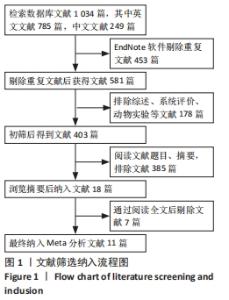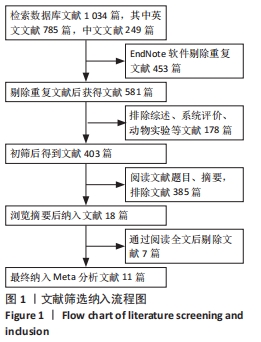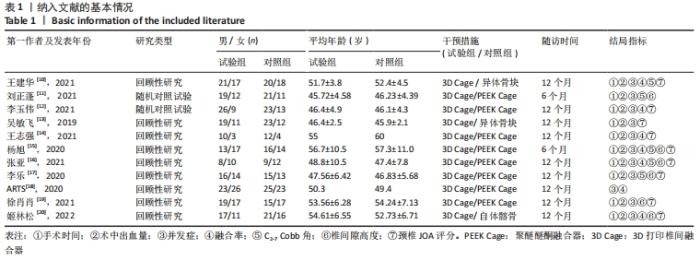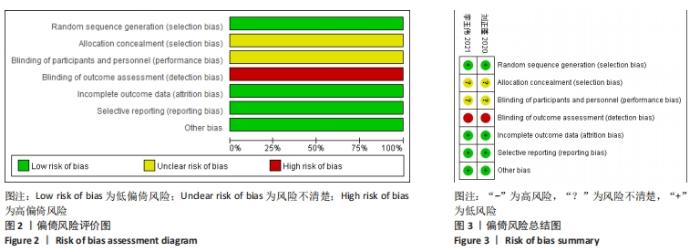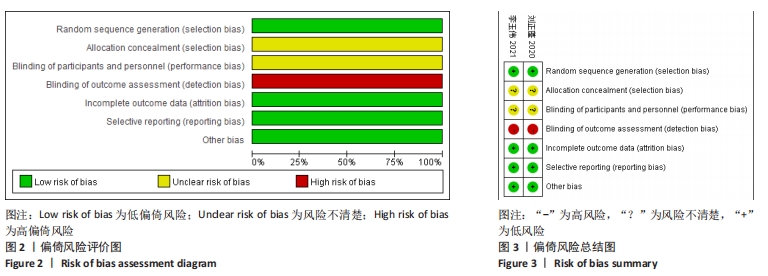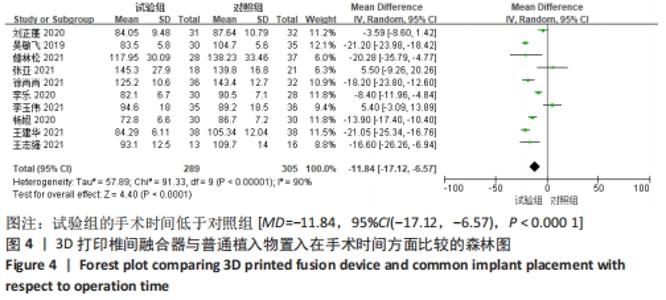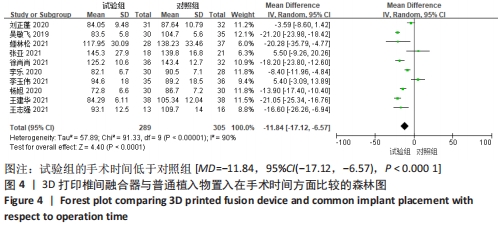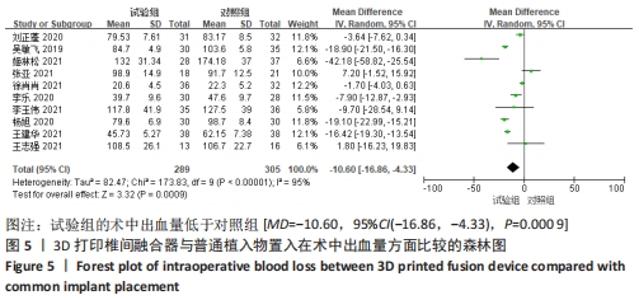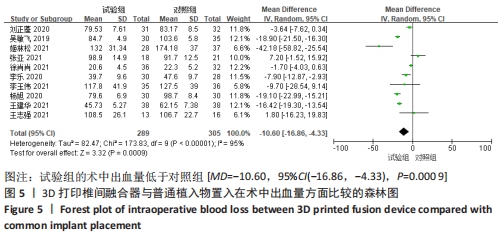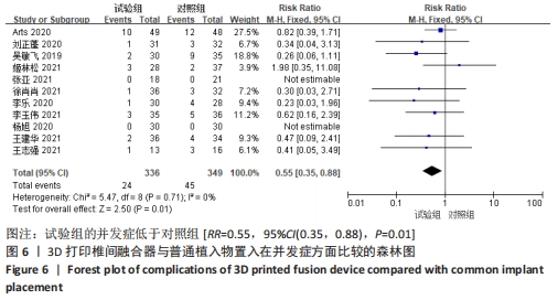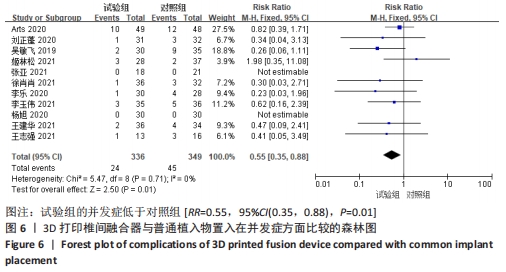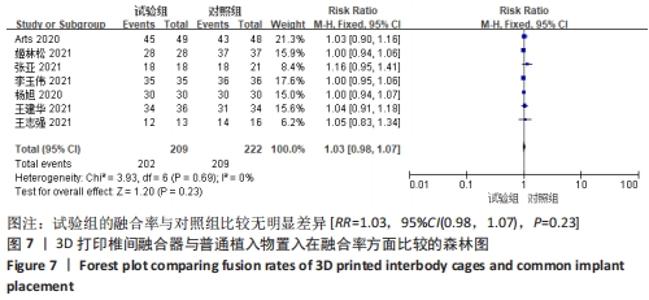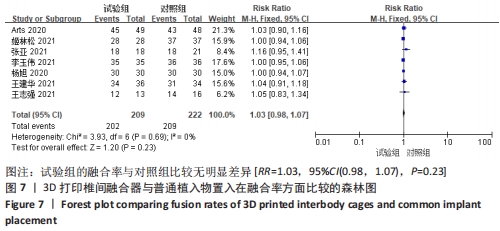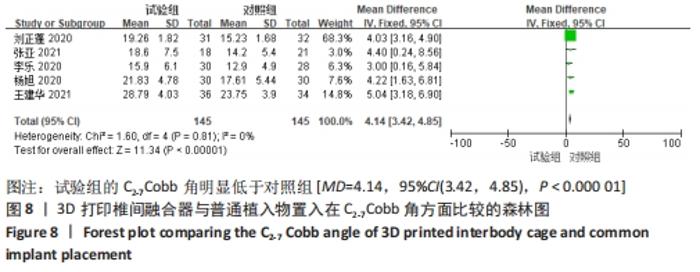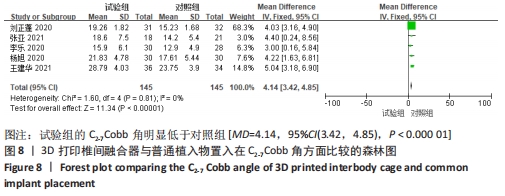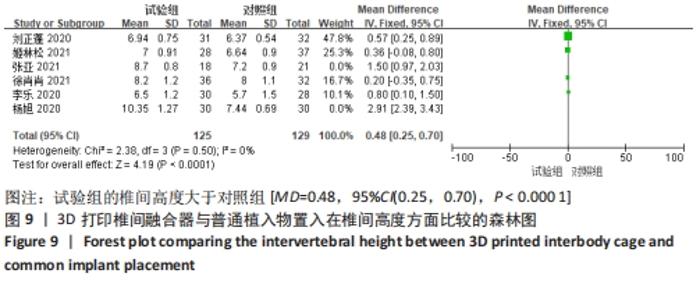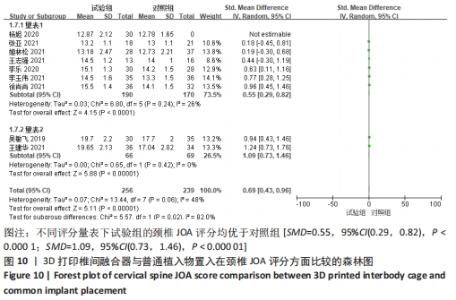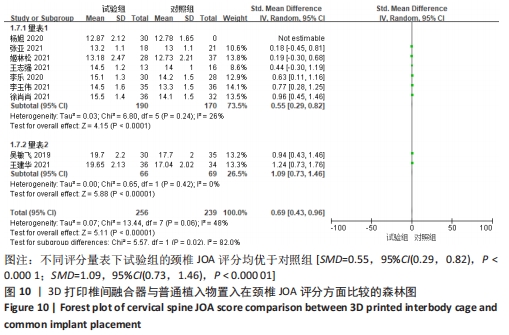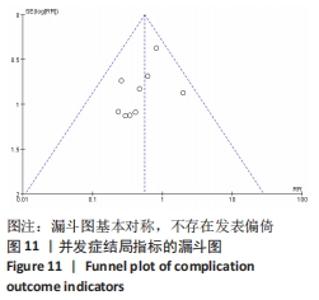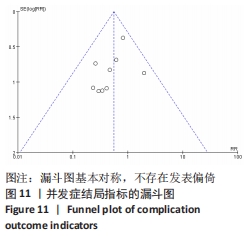Chinese Journal of Tissue Engineering Research ›› 2023, Vol. 27 ›› Issue (9): 1434-1440.doi: 10.12307/2023.263
Previous Articles Next Articles
Meta-analysis of the efficacy and safety of 3D printed porous titanium alloy fusion cage in anterior cervical discectomy and fusion
Wang Yanjin1,2, Zhou Yingjie2, Chai Xubin2, Zhuo Hanjie2
- 1Henan University of Chinese Medicine, Zhengzhou 450046, Henan Province, China; 2Luoyang Orthopedic Traumatological Hospital of Henan Province (Henan Provincial Orthopedic Hospital), Luoyang 471002, Henan Province, China
-
Received:2022-03-24Accepted:2022-05-13Online:2023-03-28Published:2022-07-02 -
Contact:Zhou Yingjie, Master’s supervisor, Chief physician, Luoyang Orthopedic Traumatological Hospital of Henan Province (Henan Provincial Orthopedic Hospital), Luoyang 471002, Henan Province, China -
About author:Wang Yanjin, Master candidate, Henan University of Chinese Medicine, Zhengzhou 450046, Henan Province, China; Luoyang Orthopedic Traumatological Hospital of Henan Province (Henan Provincial Orthopedic Hospital), Luoyang 471002, Henan Province, China -
Supported by:Key Science and Technology Project of Henan Province, No. 182102310678 (to ZYJ)
CLC Number:
Cite this article
Wang Yanjin, Zhou Yingjie, Chai Xubin, Zhuo Hanjie. Meta-analysis of the efficacy and safety of 3D printed porous titanium alloy fusion cage in anterior cervical discectomy and fusion[J]. Chinese Journal of Tissue Engineering Research, 2023, 27(9): 1434-1440.
share this article
Add to citation manager EndNote|Reference Manager|ProCite|BibTeX|RefWorks
| [1] MCCARTHY MH, WEINER JA, PATEL AA. Strategies to Achieve Spinal Fusion in Multilevel Anterior Cervical Spine Surgery: An Overview. HSS J. 2020;16(2):155-161. [2] BAYERL S, WIENDIECK K, KOEPPEN D, et al. Single- and multi-level anterior decompression and fusion for cervical spondylotic myelopathy--a long term follow-up with a minimum of 5 years. Clin Neurol Neurosurg. 2013;115(10):1966-1971. [3] LIN GX, RUI G, SHARMA S, et al. Does the Neck Pain, Function, or Range of Motion Differ After Anterior Cervical Fusion, Cervical Disc Replacement, and Posterior Cervical Foraminotomy. World Neurosurg. 2019;129:e485-e493. [4] LIU JM, XIONG X, PENG AF, et al. A comparison of local bone graft with PEEK cage versus iliac bone graft used in anterior cervical discectomy and fusion. Clin Neurol Neurosurg. 2017;155:30-35. [5] SHARMA A, KISHORE H, SINGH V, et al. Comparative Study of Functional Outcome of Anterior Cervical Decompression and Interbody Fusion With Tricortical Stand-Alone Iliac Crest Autograft Versus Stand-Alone Polyetheretherketone Cage in Cervical Spondylotic Myelopathy. Global Spine J. 2018;8(8):860-865. [6] 毛誉蓉,孙佳敏,周雄,等.医用特种高分子聚醚醚酮植入体及其表面界面工程[J].功能高分子学报,2021,34(2):144-160. [7] XU J, HE Y, LI Y, et al. Incidence of Subsidence of Seven Intervertebral Devices in Anterior Cervical Discectomy and Fusion: A Network Meta-Analysis.World Neurosurg. 2020;141:479-489. [8] MOUSSA A, TANZER M, PASINI D. Cervical fusion cage computationally optimized with porous architected Titanium for minimized subsidence. J Mech Behav Biomed Mater. 2018;85:134-151. [9] LI S, HUAN Y, ZHU B, et al. Research progress on the biological modifications of implant materials in 3D printed intervertebral fusion cages. J Mater Sci Mater Med. 2021;33(1):2. [10] 王建华,吴迪,孙贺,等.颈椎前路减压3D打印椎间融合器融合内固定术对颈椎矢状位参数的影响[J].中国脊柱脊髓杂志,2021,31(4):324-330. [11] 刘正蓬,王雅辉,张义龙,等.3D打印椎间融合器置入治疗脊髓型颈椎病:颈椎曲度及椎间高度恢复的半年随访[J].中国组织工程研究,2021,25(6):849-853. [12] 李玉伟,王海蛟,崔巍,等.前路颈椎间盘切除3D打印微孔钛合金椎间融合器与聚醚醚酮椎间融合器椎间融合术治疗脊髓型颈椎病的疗效对比[J].中国脊柱脊髓杂志,2021,31(1):16-24. [13] 吴敏飞,王洋,矫健航,等.3D打印椎间融合器在脊髓型颈椎病椎间盘摘除减压融合内固定术的应用效果[J].中华骨与关节外科杂志,2019,12(2):98-101. [14] 王志强,冯皓宇,马迅,等.3D打印人工椎体及椎间融合器在颈椎前路手术中应用的临床效果[J].中国修复重建外科杂志,2021,35(9):1147-1154. [15] 杨旭,赵晓峰,齐德泰,等.3D打印ACT钛金骨小梁椎间融合器行颈椎前路减压融合后颈椎的矢状位平衡变化[J].中国组织工程研究,2020,24(36):5741-5748. [16] 张亚,刘志维,方忠,等.3D打印钛合金椎间融合器置入治疗脊髓型颈椎病的临床疗效及颈椎矢状位参数变化[J].骨科,2021,12(2):97-102. [17] 李乐. 3D打印椎间融合器治疗颈椎病的临床研究[D].承德:承德医学院,2020. [18] ARTS M, TORENSMA B, WOLFS J. Porous titanium cervical interbody fusion device in the treatment of degenerative cervical radiculopathy; 1-year results of a prospective controlled trial. Spine J. 2020;20(7):1065-1072. [19] 徐肖肖. 3D打印钛合金融合器与PEEK融合器治疗颈椎病的短期疗效研究[D].郑州:郑州大学,2021. [20] 姬林松,王艳萍,陆廷盛,等.3D打印多孔钛合金骨小梁融合器与自体髂骨治疗脊髓型颈椎病[J].中国组织工程研究, 2022,26(18):2817-2822. [21] WALLACE N, SCHAFFER NE, ALEEM IS, et al. 3D-printed Patient-specific Spine Implants: A Systematic Review. Clin Spine Surg. 2020; 33(10):400-407. [22] LOPEZ CD, BODDAPATI V, LEE NJ, et al. Three-Dimensional Printing for Preoperative Planning and Pedicle Screw Placement in Adult Spinal Deformity: A Systematic Review. Global Spine J. 2021; 11(6):936-949. [23] ZHOU E, HUANG H, ZHAO Y, et al. The effects of titanium mesh cage size on the biomechanical responses of cervical spine after anterior cervical corpectomy and fusion: A finite element study. Clin Biomech (Bristol, Avon). 2022;91: 105547. [24] 张童童,董恩纯,郑纪豹,等.3D打印高度可调聚醚醚酮颈椎椎间融合器的优化设计与评价[J].医用生物力学,2021, 36(2):177-183. [25] 迪力努尔·塔尔江.基于3D打印的椎间融合器设计与制备研究[D].乌鲁木齐:新疆大学,2020. [26] 隋丰旭.个体化定制颈椎椎间融合器的设计及其有限元分析[D].长春:吉林大学,2021. [27] 吴昊,郭征.3D打印多孔钛与钛合金及多孔钽骨科植入物的性能比较及应用展望[J].中华创伤骨科杂志,2020,22(10):916-920. [28] TAMAYO JA, RIASCOS M, VARGAS CA, et al. Additive manufacturing of Ti6Al4V alloy via electron beam melting for the development of implants for the biomedical industry. Heliyon. 2021;7(5):e06892. [29] SIASIOS I, WINOGRAD E, KHAN A, et al. Cervical sagittal balance parameters after single-level anterior cervical discectomy and fusion: Correlations with clinical and functional outcomes. J Craniovertebr Junction Spine. 2018;9(1):56-62. [30] ROSTAMI M, MOGHADAM N, OBEID I, et al. The Impact of Single-Level Anterior Cervical Discectomy and Fusion on Cervical Sagittal Parameters and Its Correlation With Pain and Functional Outcome of Patients With Neck Pain. Int J Spine Surg. 2021;15(5):899-905. [31] HUANG H, LIU J, WANG L, et al. A critical review on the biomechanical study of cervical interbody fusion cage. Med Novel Tech Dev. 2021;11:100070. [32] LI P, JIANG W, YAN J, et al. A novel 3D printed cage with microporous structure and in vivo fusion function. J Biomed Mater Res A. 2019;107(7):1386-1392. [33] IGARASHI H, HOSHINO M, OMORI K, et al. Factors Influencing Interbody Cage Subsidence Following Anterior Cervical Discectomy and Fusion. Clin Spine Surg. 2019;32(7):297-302. [34] WU H, SHAN Z, ZHAO F, et al. Poor Bone Quality, Multilevel Surgery, and Narrow and Tall Cages Are Associated with Intraoperative Endplate Injuries and Late-onset Cage Subsidence in Lateral Lumbar Interbody Fusion: A Systematic Review. Clin Orthop Relat Res. 2022;480(1):163-188. [35] FOGEL G, MARTIN N, LYNCH K, et al. Subsidence and fusion performance of a 3D-printed porous interbody cage with stress-optimized body lattice and microporous endplates - a comprehensive mechanical and biological analysis. Spine J. 2022. doi: 10.1016/j.spinee.2022.01.003. Online ahead of print. [36] MCGILVRAY KC, EASLEY J, SEIM HB, et al. Bony ingrowth potential of 3D-printed porous titanium alloy: a direct comparison of interbody cage materials in an in vivo ovine lumbar fusion model. Spine J. 2018; 18(7):1250-1260. [37] HOU Y, YAN Z, WU Z. Concise Review; The Recent Methods that Enhance the Osteogenic Differentiation of Human Induced Pluripotent Stem Cells. Curr Stem Cell Res Ther. 2021;16(8):949-957. [38] RAPUANO BE, LEE JJ, MACDONALD DE. Titanium alloy surface oxide modulates the conformation of adsorbed fibronectin to enhance its binding to α(5) β(1) integrins in osteoblasts. Eur J Oral Sci. 2012;120(3): 185-194. [39] WO J, HUANG SS, WU DY, et al. The integration of pore size and porosity distribution on Ti-6A1-4V scaffolds by 3D printing in the modulation of osteo-differentation. J Appl Biomater Funct Mater. 2020;18:2280800020934652. [40] CHONG E, PELLETIER MH, MOBBS RJ, et al. The design evolution of interbody cages in anterior cervical discectomy and fusion: a systematic review. BMC Musculoskelet Disord. 2015;16:99. [41] 牛京喆,孙中刚,常辉,等.3D打印医用钛合金研究进展[J].稀有金属材料与工程,2019,48(5):1697-1706. |
| [1] | Peng Zhixin, Yan Wengang, Wang Kun, Zhang Zhenjiang. Finite element analysis and structural optimization design of 3D printed forearm braces [J]. Chinese Journal of Tissue Engineering Research, 2023, 27(9): 1340-1345. |
| [2] | He Yinhao, Li Xiaosheng, Chen Hongwen, Chen Tiezhu. 3D printed porous tantalum metal in the treatment of developmental dysplasia of the hip: current status and application prospect [J]. Chinese Journal of Tissue Engineering Research, 2023, 27(9): 1455-1461. |
| [3] | Jiang Xiaocheng, Shi Lu, Wang Yinbin, Li Qiujiang, Xi Chuangzhen, Ma Zefeng, Cai Lijun. Systematical evaluation of bone fusion rate after interbody fusion in patients with osteoporosis and lumbar degenerative disease treated with teriparatide [J]. Chinese Journal of Tissue Engineering Research, 2023, 27(9): 1427-1433. |
| [4] | Yu Jiaan, Liu Xinwei, Lian Hongyu, Liu Kexin, Li Zitao. Medial open-wedge tibial osteotomy versus lateral closed-wedge tibial osteotomy for unicompartmental knee osteoarthritis: a meta-analysis [J]. Chinese Journal of Tissue Engineering Research, 2023, 27(4): 632-639. |
| [5] | Xu Yangyang, He Peiliang, Meng Qingqi, Li Siming. A meta-analysis of the effects of continuous adductor canal block and continuous femoral nerve block on early activity after knee arthroplasty [J]. Chinese Journal of Tissue Engineering Research, 2023, 27(4): 640-645. |
| [6] | Chai Hao, Yang Deyong, Zhang Lei, Shu Li. 3D printing personalized osteotomy guide technology versus conventional total knee arthroplasty on the accuracy of lower limb force alignment: a meta-analysis [J]. Chinese Journal of Tissue Engineering Research, 2023, 27(4): 646-654. |
| [7] | Zhai Hongjie, Han Guanda, Li Lei, Dong Xiaohui, Jiang Zhiquan, Lou Feiyun. 3D printed polyetheretherketone material for skull defect repair [J]. Chinese Journal of Tissue Engineering Research, 2023, 27(3): 380-384. |
| [8] | Jiang Haifang, Liu Rong, Hu Peng, Chen Wei, Wei Zairong, Yang Chenglan, Nie Kaiyu. Application of 3D printing technology in the precise and personalized treatment of cleft lip and palate [J]. Chinese Journal of Tissue Engineering Research, 2023, 27(3): 413-419. |
| [9] | You Aijia, Li Wenjie, Zhou Junli, Li Chun. Systematic evaluation of six dressings on wound safety following total hip and knee arthroplasty [J]. Chinese Journal of Tissue Engineering Research, 2023, 27(3): 486-492. |
| [10] | Hu Fei, Wang Jie. Safety and efficacy of mesenchymal stem cells in the treatment of ischemic stroke: a meta-analysis [J]. Chinese Journal of Tissue Engineering Research, 2023, 27(1): 76-82. |
| [11] | Yao Xiaoling, Peng Jiancheng, Xu Yuerong, Yang Zhidong, Zhang Shuncong. Variable-angle zero-notch anterior interbody fusion system in the treatment of cervical spondylotic myelopathy: 30-month follow-up [J]. Chinese Journal of Tissue Engineering Research, 2022, 26(9): 1377-1382. |
| [12] | Jing Jinpeng, Zhang Yue, Liu Xiaomin, Liu Yi. Traditional Chinese medicine injection for promoting blood circulation in prevention of deep vein thrombosis after orthopedic surgery: network meta-analysis [J]. Chinese Journal of Tissue Engineering Research, 2022, 26(9): 1467-1476. |
| [13] | Liu Gang, Ma Chao, Wang Le, Zeng Jie, Jiao Yong, Zhao Yi, Ren Jingpei, Hu Chuanyu, Xu Lin, Mu Xiaohong. Ankle-foot orthoses improve motor function of children with cerebral palsy: a Meta-analysis based on 12 randomized controlled trials [J]. Chinese Journal of Tissue Engineering Research, 2022, 26(8): 1299-1304. |
| [14] | Song Yuxin, Zhang Tongtong, Niu Jianxiong, Wang Zengping, Wen Jie, Zhang Qunli, Xue Wen, Liu Lin. Precise screw placement of 3D printing model and orthopedic robot in spinal deformity [J]. Chinese Journal of Tissue Engineering Research, 2022, 26(6): 904-907. |
| [15] | Li Jian, Bao Zhengqi, Zhou Pinghui, Zhu Ruizhi, Li Zhixiang, Wang Jinzi. Effects of posterior single open-door laminoplasty and anterior cervical corpectomy fusion on cervical sagittal balance parameters in the treatment of multilevel cervical spondylotic myelopathy [J]. Chinese Journal of Tissue Engineering Research, 2022, 26(6): 949-953. |
| Viewed | ||||||
|
Full text |
|
|||||
|
Abstract |
|
|||||
